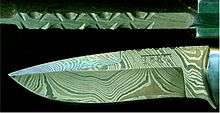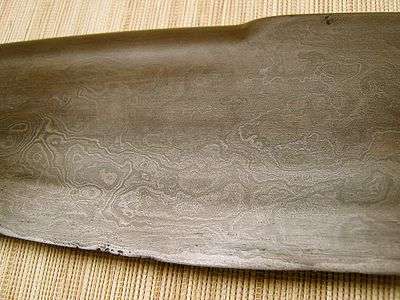Pattern welding
Pattern welding is the practice in sword and knife making of forming a blade of several metal pieces of differing composition that are forge-welded together and twisted and manipulated to form a pattern.[1] Often mistakenly called Damascus steel, blades forged in this manner often display bands of slightly different patterning along their entire length. These bands can be highlighted for cosmetic purposes by proper polishing or acid etching. Pattern welding was an outgrowth of laminated or piled steel, a similar technique used to combine steels of different carbon contents, providing a desired mix of hardness and toughness. Although modern steelmaking processes negate the need to blend different steels,[2] pattern welded steel is still used by custom knifemakers for the cosmetic effects it produces.

History


Pattern welding developed out of the necessarily complex process of making blades that were both hard and tough from the erratic and unsuitable output from early iron smelting in bloomeries. The bloomery does not generate temperatures high enough to melt iron and steel, but instead reduces the iron oxide ore into particles of pure iron, which then weld into a mass of sponge iron, consisting of lumps of impurities in a matrix of relatively pure iron, which is too soft to make a good blade. Carburizing thin iron bars or plates forms a layer of harder, high carbon steel on the surface, and early bladesmiths would forge these bars or plates together to form relatively homogeneous bars of steel. This laminating process, in which different types of steel together produce patterns that can be seen in the surface of the finished blade, forms the basis for pattern welding.[3][4]
Pattern welding in Europe
Pattern welding dates at least back to the Romans.[5] By the 2nd and 3rd century AD, the Celts commonly used pattern welding for decoration in addition to structural reasons. The technique involves folding and forging alternating layers of steel into rods, then twisting the steel to form complex patterns when forged into a blade.[3] By the 6th and 7th centuries, pattern welding had reached a level where thin layers of patterned steel were being overlaid onto a soft iron core, making the swords far better as the iron gave them a flexible and springy core that would take any shock from sword blows to stop the blade bending or snapping. Arguably the most famous group of pattern-welded Viking swords – and incidentally one of the first known examples of value being increased by the presence of a brand name – are the Ulfberht swords, of which 166 are known to exist. By the end of the Viking era, pattern welding fell out of use in Europe.[4][4][6]
In medieval swords, pattern welding was more prevalent than commonly thought. However, the presence of rust makes detection difficult without repolishing.[5]
During the Middle ages, Damascus steel was produced in India and brought back to Europe. The similarities in the markings led many to believe it was the same process being used, and pattern welding was revived by European smiths who were attempting to duplicate the Damascus steel. While the methods used by Damascus smiths to produce their blades was lost, recent efforts by metallurgists and bladesmiths (such as Verhoeven and Pendray) to reproduce steel with identical characteristics have yielded a process that does not involve pattern welding.[3] However even these attempts have not been a huge success.
Modern decorative use
The ancient swordmakers exploited the aesthetic qualities of pattern welded steel. The Vikings, in particular, were fond of twisting bars of steel around each other, welding the bars together by hammering and then repeating the process with the resulting bars, to create complex patterns in the final steel bar. Two bars twisted in opposite directions created the common chevron pattern. Often, the center of the blade was a core of soft steel, and the edges were solid high carbon steel, similar to the laminates of the Japanese.
The American Bladesmith Society's Master Smith test, for example, requires a 300 layer blade to be forged. Large numbers of layers are generally produced by folding, where a small number of layers are welded together, then the blank is cut in half, stacked, and welded again, with each operation doubling the number of layers. Starting with just two layers, eight folding operations will yield 512 layers in the blank. A blade ground from such a blank will show a grain much like an object cut from a block of wood, with similar random variations in pattern. Some manufactured objects can be re-purposed into pattern welded blanks. "Cable Damascus", forged from high carbon multi-strand cable, is a popular item for bladesmiths to produce, producing a finely grained, twisted pattern, while chainsaw chains produce a pattern of randomly positioned blobs of color.[7][8][9]
Some modern bladesmiths have taken pattern welding to new heights, with elaborate applications of traditional pattern welding techniques, as well as with new technology. A layered billet of steel rods with the blade blank cut perpendicular to the layers can also produce some spectacular patterns, including mosaics or even writing. Powder metallurgy allows alloys that would not normally be compatible to be combined into solid bars. Different treatments of the steel after it is ground and polished, such as bluing, etching, or various other chemical surface treatments that react differently to the different metals used can create bright, high-contrast finishes on the steel. Some master smiths go as far as to use techniques such as electrical discharge machining to cut interlocking patterns out of different steels, fit them together, then weld the resulting assembly into a solid block of steel.[9]
See also
- Bulat steel, a Russian crucible steel
- Damascus steel, a steel used in swordmaking during the medieval period
- Forged in Fire a History channel competitive television show on forged knife and sword making
- Hamon (swordsmithing)
- Japanese sword construction includes a specific form of pattern welding.
- Mokume-gane, a similar technique, often Fprecious metals, used to produce decorative pieces
- Wootz steel, an Indian crucible steel
References
- Birch 2013, pp. 127–134.
- Verhoeven 2002, p. 357.
- Verhoeven 2002, pp. 356-365.
- Peirce & Oakeshott 2004.
- Williams 2012, p. 75.
- Peirce, Oakeshott & Jones 2007, p. 145.
- Goddard 2000, pp. 107–120.
- Caffery, Ed. "Damascus Pictoral". Archived from the original on 2011-07-23.
- Caffery, Ed. "Bits of Steel". Archived from the original on 2005-12-15 – via Internet archive.
Sources
- Birch, Thomas (2013). "Does pattern-welding make Anglo-Saxon swords stronger?". In Dungworth, David & Doonan, Roger C. P. (eds.). Accidental and Experimental Archaeometallurgy. HMS Occasional Publications. 7. London: The Historical Metallurgy Society. pp. 127–134. ISBN 978-0-9560225-1-6.CS1 maint: ref=harv (link)

- Durand-Charre, Madeleine (2014). Damascus and pattern-welded steels - Forging blades since the iron age: Forging blades since the iron age: Science des matériaux (Reprint ed.). Les Ulis, France: EDP Sciences. ISBN 978-2759816354.CS1 maint: ref=harv (link)
- Engstrom, Robert; Lankton, Scott Michael & Lesher-Engstrom, Audrey (1989). A Modern Replication Based on the Pattern-Welded Sword of Sutton Hoo. Kalamazoo, Michigan: Medieval Institute Publications, Western Michigan University. ISBN 0-918720-29-X.CS1 maint: ref=harv (link)
- Goddard, Wayne (2000). The Wonder of Knifemaking. Iola, Wisconsin: Krause Publications. pp. 107–120. ISBN 978-0-87341-798-3.CS1 maint: ref=harv (link)
- Hrisoulas, Jim (May 1, 1994). The Pattern-Welded Blade: Artistry In Iron (Illustrated ed.). Paladin Press. ISBN 9781581605440.CS1 maint: ref=harv (link)
- Lang, Janet. The Rise and Fall of Pattern Welding: An Investigation Into the Construction of Pre-medieval Sword Blades. University of Reading. School of Human and Environmental Sciences.CS1 maint: ref=harv (link)
- Maryon, Herbert (1948). "A Sword of the Nydam Type from Ely Fields Farm, near Ely". Proceedings of the Cambridge Antiquarian Society. Cambridge Antiquarian Society. XLI: 73–76. doi:10.5284/1034398.
- Maryon, Herbert (February 1960). "Pattern-Welding and Damascening of Sword-Blades—Part 1: Pattern-Welding". Studies in Conservation. Taylor & Francis, Ltd. on behalf of the International Institute for Conservation of Historic and Artistic Works. 5 (1): 25–37. doi:10.2307/1505063. JSTOR 1505063.
- Maryon, Herbert (May 1960). "Pattern-Welding and Damascening of Sword-Blades—Part 2: The Damascene Process". Studies in Conservation. Taylor & Francis, Ltd. on behalf of the International Institute for Conservation of Historic and Artistic Works. 5 (2): 52–60. doi:10.2307/1504953. JSTOR 1504953.
- Meilach, Dona Z. (1977). Decorative and Sculptural Ironwork: Tools, Techniques, Inspiration (1st ed.). New York City: Crown Publishers, Inc. ISBN 0-517-52731-6.CS1 maint: ref=harv (link)
- Meilach, Dona Z. (1999). Decorative and Sculptural Ironwork: Tools, Techniques & Inspiration (2nd ed.). Atglen, Pennsylvania: Schiffer Publishing. ISBN 0764307908.CS1 maint: ref=harv (link)
- Peirce, Ian; Oakeshott, Ewart; Jones, Lee A. (May 24, 2007). "Blade Construction and Pattern-Welding". Swords of the Viking Age: catalogue of examples (New ed.). Woodbridge, UK, Rochester, NY: Boydell & Brewer, Limited. p. 145. ISBN 9781843830894.CS1 maint: ref=harv (link)
- Peirce, Ian G. & Oakeshott, Ewart (2004). Swords of the Viking Age. Woodbridge: Boydell Press. ISBN 0-85115-914-1.CS1 maint: ref=harv (link)
- Verhoeven, John D. (2002). "Genuine Damascus Steel: a type of banded microstructure in hypereutectoid steels" (PDF). Materials Technology. Iowa State University. Steel Research, 73 (8): 356–365. Archived from the original (PDF) on 3 September 2006 – via Internet Archive.CS1 maint: ref=harv (link)
- Williams, Alan (May 3, 2012). The Sword and the Crucible: A History of the Metallurgy of European Swords Up to the 16th Century (Hardcover). History of Warfare (Book 77). Leiden: Brill Publishers. p. 75. ISBN 978-9004227835.CS1 maint: ref=harv (link)
External links
- Bladesmith Kevin Cashen's page on pattern welding
- Ancient carburisation of iron to steel: a comment
- Mediæval Sword Virtual Museum, which contains close-up images of Viking swords, showing the pattern welding structures.